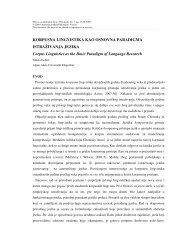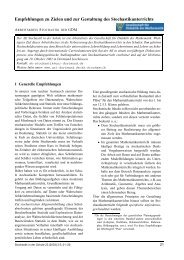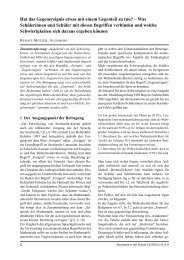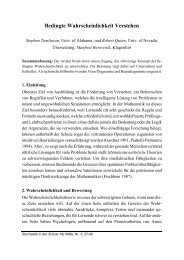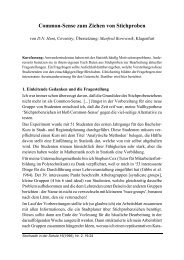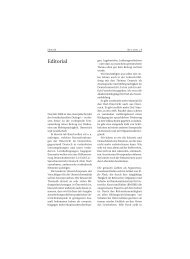Adi Wimmer: The Musical Hair.
Adi Wimmer: The Musical Hair.
Adi Wimmer: The Musical Hair.
Create successful ePaper yourself
Turn your PDF publications into a flip-book with our unique Google optimized e-Paper software.
<strong>Adi</strong> <strong>Wimmer</strong>:<br />
<strong>The</strong> <strong>Musical</strong> <strong>Hair</strong>.<br />
(Published in: Helbig, Jörg and Simon Warner, eds., 2008. Summer of Love.<br />
<strong>The</strong> Beatles, Art and Culture in the Sixties. WVT, 205-16)<br />
In the late 60s and early 70s, the musical <strong>Hair</strong> influenced the generation of 17-<br />
30 year olds like no other musical did, before or after.<br />
<strong>Hair</strong> was more than just another musical in a city that is renown for its<br />
Broadway musicals. It held out the promise of a new era, an era characterized by<br />
peace, love and harmony. Hopes for such a new era were great in 1967 as we<br />
have heard in previous papers, and they are invested in a song that has, 40 years<br />
after, a recognition value as great as the song “Sgt. Pepper’s Lonely Heart’s<br />
Club Band.” Whenever you see a TV documentary on the 60s, or the hippies, or<br />
the anti-war movement, you are likely to hear the song “Aquarius”. (Even when<br />
one accesses the musical’s official website (www.hairthemusical/com) the first<br />
thing one hears is this song.)<br />
1. From the theatrical fringe to Broadway. <strong>Hair</strong> and its social context.<br />
<strong>Hair</strong> was launched on Sept. 17, 1967. Its authors James Rado and Jerome Ragni<br />
had worked on it for roughly two years, and then they found the congenial<br />
former South African composer Galt McDermot, who “was trying to<br />
communicate the elements of freedom” in his songs (Horn 28). <strong>The</strong>ir Grand<br />
Narrative was an exploration of the new “hippie” Zeitgeist. Hippiedom had<br />
made a profound impact on American culture in the previous two years; the term<br />
was first used by Michael Fallon in the San Francisco Chronicle on Sept 5 th ,<br />
1965. Following the publication of this first essay on the hippie Zeitgeist, teams<br />
of researchers went into the Haight-Ashbury district of San Francisco, and the<br />
1
East Village in New York to describe what was understood to be the second<br />
generation of Beats. Rado and Ragni too did field work amongst hippies, later<br />
using it as raw material for the musical. A consensus emerged that hippiedom<br />
was a counterculture made up by the children of the affluent middle class that<br />
lived in rejection of their parents’ values. Its members were first of all<br />
characterized by a general anti-establishment attitude and visually, by their long<br />
hair. <strong>The</strong> middle passage of the song “<strong>Hair</strong>” has the following lyrics:<br />
Long, beautiful, gleaming, steaming, flaxen, waxen, curly, fuzzy, snaggy, shaggy,<br />
ratty, matty, oily, greasy, fleecy, down-to-there hair, hair like Jesus wore it, hallelujah,<br />
I adore it, why don’t my mother like my haaaaaair...”.<br />
Hippies embraced all people of colour and were generally anti-racist. Most of<br />
them also displayed a liberal sexual behaviour, a drop-out attitude and quite<br />
generally smoked marijuana. Barbara Lee Horn, an authority on <strong>Hair</strong> reports<br />
that smoking of dope was a general practice fore the whole length of the<br />
Broadway run, which made productions wildly unpredictable (92). Many times,<br />
certain cast members were too stoned to appear on stage, and absenteeism was a<br />
general problem. Additional concerns included the environment, poverty,<br />
religion and a dislike of the military. <strong>The</strong> main theme however is the protest<br />
against the war in Vietnam, with anti-racism coming a close second. At one<br />
stage Hud, the black tribe member, asks: “why do white men send black men<br />
away to kill yellow men to defend a country which they stole from the red<br />
men?” In this query we find the anti-war issue intertwined with the Civil rights<br />
movement.<br />
So much for the social context. <strong>The</strong> artistic context requires some comment, too.<br />
<strong>The</strong>atre in the 1960s was vibrant, on either side of the Atlantic. Experiments<br />
were the order of the day. In New York, an entirely new theatrical scene<br />
developed in the early 1960s that was located “off Broadway”, in Soho,<br />
Greenwich Village and the Bowery, with enterprises such as the legendary “La<br />
Mama” theatre, the “Living <strong>The</strong>atre” and the “La MaMa Experimental <strong>The</strong>atre<br />
2
Company.” In Europe meanwhile, Samuel Beckett had popularized his “<strong>The</strong>atre<br />
of the Absurd”, Grotowsky had called for a “poor theatre”, Antonin Artaud<br />
advocated a “<strong>The</strong>atre of Cruelty”, by which was meant a theatre assaulting all<br />
senses rather than a timid, cerebral affair. Some of these ideas had already<br />
filtered into the American <strong>Musical</strong>. For 50 years, from Oklahoma in the 1920 to<br />
West Side Story (1961) musicals had followed a well-developed script. Critics<br />
however were saying this genre had exhausted itself. <strong>The</strong> alternative should be a<br />
musical whose forte was not strong plotting, but a “concept” developed in<br />
workshops by the cast as well as writers, composers and choreographers. Such a<br />
“concept musical” was launched off Broadway in September 1966 and its title<br />
was Viet Rock. This prototype owed much to Joe Papp, the creator of the New<br />
York “Public <strong>The</strong>atre” (1965) and the annual “Shakespeare in the Park” festival,<br />
which is still an important feature of New York’s theatrical summer culture. So<br />
when the two authors James Rado and Jerome Ragni were rejected by<br />
Broadway, one producer after the other, and then miraculously accepted by Joe<br />
Papp for a limited 8 week run at his Public <strong>The</strong>atre, a deal was quickly struck.<br />
Joe Papp’s influence can be felt in one song which borrows its words verbatim<br />
from Hamlet Act II/2, l. 261-274. Its title is “What a piece of work is man”.<br />
According to Horn, Joe Papp did not show sufficient interest to sell his<br />
production to any of the Broadway companies, and so it seemed as if the<br />
<strong>Musical</strong> was finished. But then, a second miracle occurred. One of the last<br />
shows at the Public <strong>The</strong>atre was seen by Michael Butler, youthful scion of the<br />
exceedingly wealthy Butler dynasty of Chicago. Butler had worked with both<br />
JFK and RFK, and had (unsuccessfully) run for Congress in 1966. Butler’s pet<br />
concern was the continued mistreatment of Native Americans, and he had<br />
become aware of the production at the Public only because the original poster<br />
featured a famous photograph of Sitting Bull, Geronimo and other chieftains.<br />
Butler then secured the rights for a Broadway performance, which he himself<br />
3
produced. Rado and Ragni, who had had endless quarrels with Joe Papp (Horn,<br />
15), called him a “dream producer”. He gave them all the freedom they wanted,<br />
and it was his idea to introduce the term “the tribe” for the show’s cast. He also<br />
encouraged the cast to share their accommodation, their property, their food and<br />
their clothes – which was to have a disastrous consequence later for one of the<br />
spin-off productions in Cleveland (more in a moment). As artistic director he<br />
hired Bertrand Castelli, a writer-producer with a first class reputation who had<br />
worked with Jean Cocteau, Picasso and Raoul Dufy, to name but three. At the<br />
time Castelli was the director of a ballet company and he was able to bring in a<br />
number of experimentalists, including Andy Warhol (if you please) and Tom<br />
O’Horgan to “inject vitality into the precious, static, obsolete world of ballet”<br />
(Horn 37).<br />
In the winter of 1967/68 the “tribe” staged the show as it had been prepared for<br />
the premiere at the run-down “Cheetah” discotheque on 45 th Street, while at the<br />
same time rehearsing for the opening at the Biltmore <strong>The</strong>atre on Broadway,<br />
which then happened on 29 April 1968.<br />
2. Broadway and the public’s changed views on the Vietnam War<br />
<strong>The</strong> World Premiere at the Public <strong>The</strong>atre of Sept. 1967 did not take New York<br />
by storm. This had more to do with the timing of the show than its inherent<br />
quality. In 1967, the country was still behind the Johnson government regarding<br />
the war in Vietnam, and the hippie counterculture so lovingly portrayed in <strong>Hair</strong><br />
was viewed with suspicion. But on 29 April 1968 came the Broadway launch in<br />
the ‘Biltmore’ theatre, where it stayed for 1,750 performances. Only seven<br />
months had passed since the world premiere at Joe Papp’s venue, but these were<br />
months of great political change. On January 31 st 70.000 Vietcong unleashed<br />
their “TET” Offensive (Karnow 523) during which American TV viewers were<br />
4
stunned to find that an enemy that had been described as practically defeated by<br />
their government, was able to launch an offensive throughout South Vietnam.<br />
Even the US embassy in Saigon fell into the enemy’s hands for a day. Johnson’s<br />
optimistic assessment that he had the VC “on the run” was exposed as a lie.<br />
Walter Cronkite, who at the time was generally regarded “the nation’s most<br />
reliable journalistic personality” (Karnow, 547) was representative for<br />
America’s mood swing when he went before the cameras on February 27 th 1968,<br />
declaring that it seemed “more certain than ever that the bloody experience of<br />
Vietnam is to end in stalemate.” (qut. by Karnow, ibid) On March 10, the New<br />
York Times revealed a hitherto secret plan to send an additional 206.000 troops<br />
to Vietnam, at the request of General Westmoreland. <strong>The</strong> public response was<br />
one of outrage, and Johnson was forced to scrap the plan. And on April 2 the<br />
first Democratic “primary” since TET was held in Wisconsin, in which the<br />
hitherto largely unknown peace candidate Eugene McCarthy received only 300<br />
votes less than the incumbent president Lyndon Baines Johnson. Thus the anti-<br />
war message of <strong>Hair</strong> found a highly receptive audience.<br />
3. <strong>Hair</strong> spreads across the nation and to Europe<br />
<strong>The</strong>re were other success factors. Its refreshingly outspoken references to sex,<br />
dope and nudity turned show into instant commercial success. <strong>The</strong> reviewers<br />
were at first divided between the traditionalists (who hated the formlessness of<br />
<strong>Hair</strong> and its anti-establishment messages) and the more progressive critics. Clive<br />
Barnes, the New York Times critic wrote in his review (April 29, 1968):<br />
<strong>Hair</strong> is now a musical with a theme, not a story. Nor is this all that has been done in<br />
this totally new, all lit-up, gas-fired, speed-marketed Broadway version. For one thing<br />
it has been made a great deal franker. In fact it has been made into the frankest show<br />
in town - and this has been a season not noticeable for its verbal or visual reticence.”<br />
Later he goes on to say that many four letter words are used, for instance “love”.<br />
Walter Winchell, theatre critic of the NY Daily news (a tabloid!) wrote:<br />
5
This veteran of the Broadway scene since 1920 has seen almost everything on and off a<br />
stage, but he has never witnessed anything like "<strong>Hair</strong>" which came to the Biltmore<br />
asylum last night. It is the most exciting entertainment in town. Tennessee Williams,<br />
Edward Albee, LeRoi Jones and other masters of four-letter-word literature are made to<br />
appear old-hat, dated and obsolete by the graffiti in "<strong>Hair</strong>." It may force the abovenamed<br />
greats out of show business. It is authentic Hippieville with a large cast of young<br />
people, many of whom are talented, attractive and naked.<br />
Negative reviews there were, too. David Merrick, a traditionalist show producer,<br />
said: “I don’t know what the hell this is. I don’t know why people like it”. Or<br />
take John Chapman (Daily News): “… vulgar, perverted, tasteless, cheap,<br />
cynical, offensive, and generally lousy, and everybody connected with it should<br />
be washed in strong soap and hung up to dry in the sun.” (Both qut. by Horn,<br />
86). Note the strident tone typical for a hatred towards the counterculture. One<br />
more, by Jack O’Brien: “a mad-mod musical … whose cast look permanently<br />
bathless, whose points are not irreverent but sacrilegious, its hymns of love are<br />
evilly hateful” (qut. Horn, 88). Some of the negativity was not caused by<br />
prudery or patriotism, but by a resentment that such art- and formlessness as is<br />
manifested in <strong>Hair</strong> should be rewarded. This resentment has never completely<br />
faded away. Some historians of the American musical have been curiously curt<br />
and tightlipped about <strong>Hair</strong>. Ian Bradley (2004, 105) devotes exactly 7 lines (in a<br />
monograph of 245 pages) to the musical, condemning it as “one long dream<br />
sequence from beginning to end – the dream in this case being more drug-<br />
induced hallucination and fantasy than a vision of a better world.” While Scott<br />
Miller’s monograph (1996) manages not to mention <strong>Hair</strong> at all. He ignores it<br />
completely.<br />
Although there were quite a number of NY critics who lambasted the show’s<br />
formlessness, or the anti-establishment stance, or its positive stance on mind-<br />
enhancing drugs, these grouches were swept aside by a chorus of critical voices<br />
that praised <strong>Hair</strong> as exciting, youthful, new, and vibrant. Leonard Probst (1968)<br />
of the NBC praised it as the “only new concept in musicals on Broadway and<br />
more fun than any other this season.” Cecil Smith of the LA Times (1968) is<br />
6
noticeably traditionalist in his sympathetic assessment: “But the most moving<br />
lyric in the show, and perhaps the most beautiful song, is ‘What a Piece of Work<br />
Is Man?’ for a play called ‘Hamlet’ by a man named Shakespeare.”<br />
After the first two weeks, the show was booked out for months ahead. <strong>The</strong><br />
critics wrote that with <strong>Hair</strong>, a new age, the Age of Aquarius, had dawned. This<br />
was to be an age of peace and harmony, of communal love, an age that would<br />
abolish war and racial discrimination, aggression and crime. <strong>The</strong> values of<br />
competitive individualism would be replaced by the values of joyful sharing and<br />
collectivism: hence the importance of the term “tribe” instead if “cast”. This<br />
message is very well transported in the well-known song “Aquarius”, which we<br />
heard at the beginning of this presentation. Note that at the start of the number a<br />
morning is musically evoked, with the members of the tribe gradually<br />
awakening and forming a chorus that begins to chant the key words of the new<br />
Age.<br />
4. What is <strong>Hair</strong> about?<br />
<strong>The</strong> plot is threadbare and less important than the messages of the individual<br />
songs combined. We follow a group of politically active Hippies of the “Age of<br />
Aquarius" who fight against conscription to the Vietnam War while living a<br />
bohemian life together in a New York loft. Claude is the nominal group leader;<br />
Berger an irreverent free spirit; Sheila is a New York University film student in<br />
love with both of them; Woof a bi-sexual gentle soul; Jeanie is in love with<br />
Claude but pregnant by another man; Hud is a Black Panther; Crissy, Dionne<br />
and others struggle to balance their young lives and loves with their Vietnam<br />
war resistance and the conservative ideology of their society.<br />
When the men of the tribe receive a draft notice, they conduct a draft-burning<br />
ceremony, except for Claude, whose sense of responsibility restrains him.<br />
7
Ultimately, he is inducted to the army and sent to Vietnam. Claude's repeated<br />
failure to burn his draft card can be interpreted as a Hamlet syndrome. His<br />
loyalty to his country and his inability to take decisive action causes his death in<br />
Southeast Asia. In the last scene he appears as a ghostly apparition wearing a US<br />
uniform. <strong>The</strong> film version by Milos Forman has a more complex plot in which<br />
Berger is the tribal leader while Claude has arrived from rural Oklahoma to<br />
present himself before a Vietnam draft board. After some irreverent tribal antics<br />
(which includes gate-crashing a party of the NYC Upper Crust) the tribe follow<br />
Claude to Nevada, where he undergoes basic training. Berger then poses as<br />
Claude (exchanging clothes, even sacrificing his hair) so that Claude can have a<br />
final meeting with his sweetheart Sheila. Moments after Berger has snuck into<br />
the barracks (where he only plans to spend one night), to his horror a senior<br />
officer arrives who orders the whole unit to march into an aircraft that takes<br />
them to the Nam. In the final scene we see a gravestone amidst thousands of<br />
other gravestones with his name on it and the word “Vietnam”.<br />
5. Nudity and opposition to the show.<br />
<strong>The</strong> original New York tribe included both James Rado and Gerome Ragni, as<br />
well as Diane Keaton. <strong>The</strong> show’s greatest notoriety was a scene at the end of<br />
Act 1 in which the whole cast appear nude on the stage, symbolically signifying<br />
that the tribe have nothing to hide. Diane Keaton however included a clause in<br />
the contract that allowed her not to appear nude in that finale. She left the “tribe”<br />
after only a few months when Woody Allan offered her a major role in his<br />
movie Manhattan.<br />
But that nude scene caused a lot of problems to the musical’s producer and<br />
authors. Not so in New York, where Butler had made discreet inquiries about<br />
how the NYPD would react to the nudity, finding that it would be quietly<br />
8
tolerated. But only 300 miles further north, there was trouble in a city that is<br />
otherwise well known for its liberality and tolerance: Boston.<br />
<strong>Hair</strong> has made legal history. In March 1969, the show in Boston was stopped<br />
after only one performance because a local district attorney thought it violated<br />
the laws pertaining to obscenity. Seven judges had attended it; after the viewing<br />
their verdict was to ban it in toto. <strong>The</strong> judges suggested that the actors put on<br />
some discreet underwear for the end of Act One, and that the American flag<br />
during the song “don’t put it down” should not touch the ground. (Certain<br />
members of the military had complained that the Star Spangled banner was<br />
being desecrated during the show.) Producer Michael Butler however stood<br />
firm: he continued to pay the Boston cast for a whole month while the matter<br />
was taken to the Supreme Court. <strong>The</strong> verdict was that the show should proceed<br />
as it had in New York, as the Boston ban violated the First Amendment (“a ban<br />
would have a chilling effect on the freedom of artistic expression” was its key<br />
sentence.)<br />
A different legal battle was fought in Chattanooga, Tennessee. <strong>The</strong>re the<br />
authorities did not grant the show even a preview, banning it on the grounds of<br />
what had been reported about it. When Butler wanted to take this decision to the<br />
Supreme Court as well, the state of Tennessee found a number of legal tricks to<br />
prevent it. It was only five years later, in 1975, that the Supreme Court once<br />
again ruled that not to give a musical play a venue constituted “unlawful prior<br />
restraint” and was thus in violation of the Constitution. But by that time, the<br />
show had run out of steam and so there never was a Chattanooga performance.<br />
In a TV documentary on <strong>Hair</strong> (Rapaport 2007) Michael Butler explains that<br />
opposition to him and to members of the tribe was no joke. He received a<br />
number of death threats over the phone, which, so he claims, the FBI traced<br />
9
ack to the reactionary John Birch society, without taking legal action against<br />
them. Real tragedy struck in 1970 in Cleveland. <strong>The</strong> hotel where virtually all the<br />
cast and their families were staying (following Michael Butler’s advice that for<br />
reasons of public relations the “tribe” should keep close social contacts during<br />
the shows) was torched. <strong>The</strong> police concluded that the fire’s cause was arson.<br />
Four people died in the blaze, including the wife and little daughter of one of the<br />
actors. No-one was ever prosecuted for this deadly attack.<br />
6. How did the musical affect the US and Europe?<br />
<strong>Hair</strong> did not have as many runs as previous musicals such as Oklahoma,<br />
Showboat, or West Side Story, and it was eclipsed by subsequent musicals like<br />
<strong>The</strong> Phantom of the Opera, which still holds the record on Broadway. However,<br />
it was without any doubt a milestone in the history of the Broadway musical, as<br />
it was a milestone regarding art and society in Europe. It was the first rock<br />
musical on Broadway and thus a trend-setter. It brought the hippie culture to the<br />
attention of mainstream America. Owing to <strong>Hair</strong>, hippie culture left the domain<br />
of the United States and went global.<br />
As a musical, <strong>Hair</strong> spread faster and further than any other musical before or<br />
since. A West Coast production was launched on Dec 4 th 1968 in Los Angeles to<br />
rave reviews. One of the reviewers noted that during a scene depicting an anti-<br />
war demonstration, one of the actors waved a placard that ingeniously said<br />
“Nixon is Rosemary’s baby” (qut. Chamberlain). Within one year, there were 14<br />
productions across the USA and one in London, at the venerable Shaftesbury<br />
<strong>The</strong>atre. After one year of generally sold-out performances, the Broadway tribe<br />
held a free open air performance in Central Park, to an audience of 10.000. By<br />
then, the show had netted a profit of 2 million dollars. Within two years, there<br />
were productions in London, Paris, Copenhagen, Amsterdam, Helsinki, Munich,<br />
10
Rome, Stockholm, Bergen, Rio de Janeiro, Buenos Aires, Tel Aviv, Tokyo and<br />
Sydney. Like the Beatles, <strong>Hair</strong> had become a global phenomenon,<br />
Many more productions followed in the early 1970s. <strong>The</strong> movie <strong>Hair</strong>, directed<br />
by Milos Forman, was launched in 1979 but did not have the approval of the<br />
original authors who felt that it was too neat and mainstream to do justice to the<br />
original show’s irreverence. In 1988, for the 10-year anniversary, there was a re-<br />
union of the original Broadway tribe and a one-night gala performance in the<br />
Grand Assembly Hall of the United Nations. <strong>The</strong> patrons of the show were the<br />
current UN General Secretary Perez de Cuellar, Nancy Reagan, and Barbara<br />
Walters, who introduced it to the audience. Ticket prices ranged from 500 to<br />
5000 dollars, and the proceeds went towards the US AIDS foundation. <strong>The</strong><br />
legendary Dr Ruth Westheimer, who had pioneered sex counselling on<br />
American TV, gave a brief appearance as the lady from the audience asking why<br />
the tribe wear their hair so long, which leads into the song “My Conviction”. As<br />
a result of the UN revival, the 1990s saw a spate of revivals, not only in the<br />
USA but across the globe. In 1991, there were 13 separate recordings, in 2007,<br />
there are 36 albums, including an Austrian, an Israeli and an Icelandic album.<br />
Together they have sold millions of copies. Forbes magazine reported that no<br />
fewer than four million people saw the show within the first two year, and that it<br />
earned a total of 22 million dollars during that time. When it completed its<br />
American run in the mid-1970s, it had earned 80 million (Horn, xiv). <strong>The</strong><br />
amount earned from overseas productions probably exceeded those 80 million<br />
dollars, and the show as well as the recordings continue to make millions of<br />
dollars with each additional year. Currently there are 19 revivals in the USA,<br />
and in at least another 9 countries worldwide: Canada, Belgium, Switzerland,<br />
Australia, Austria, South Africa, the UK, Argentina and Germany. <strong>The</strong>re may be<br />
more of which we do not know. An Austrian production premiered on July 20 th<br />
2007 at Amstetten. It follows a radically revised 2001 revival in Vienna which<br />
11
was highly successful at the time, running for more than two years. In 2005, a<br />
London revival at the Gate <strong>The</strong>atre repositioned the musical into the context of<br />
George Bush’s oil war against Iraq, with the express approval of the authors and<br />
Michael Butler.<br />
I have personal memories of how the arrival of <strong>Hair</strong> was reported in the<br />
Austrian media. Unlike in the USA, there were hardly any negative voices: the<br />
nudity was mentioned but there was no shrill criticism of it, the protest against<br />
the war in Vietnam was already out in the popular press and so did not raise any<br />
objections, the popularisation of values such as peace and racial harmony was<br />
praised. About the Shaftesbury <strong>The</strong>atre premiere in London it was widely<br />
reported that the show was booked out a year ahead, which turned out to be not<br />
true when I went to buy a ticket in July of 1969. <strong>The</strong> London production initially<br />
had overwhelmingly negative reviews. <strong>The</strong> only dissenter wasthe London<br />
Times’ theatre critic. He wrote: "Nothing else remotely like it has yet struck the<br />
West End. Its honesty and passion give it the quality of a true theatrical<br />
celebration - the joyous sound of a group of people telling the world exactly<br />
what they feel" (Wardle 1968). Like before in NYC, this view was to prevail<br />
over the next weeks and months.<br />
As it conquered Europe, <strong>Hair</strong> created its own local headlines. In London for<br />
instance, where the office of the official censor was abolished just before the<br />
show opened, the authorities did not create any fuss about the nudity, but some<br />
of the cast refused to strip to their birthday suits. (Ironically, one year later a<br />
West-Comedy with the title of No Sex Please We’re British was premiered. It<br />
ran for 5 years.) <strong>The</strong> reason given by the prudish members of the cast was that<br />
the nudity detracted from the play’s central message, which was the criminality<br />
of the war in Vietnam. Incidentally, the London show ran for 1,997 nights,<br />
longer than the Broadway show, and when it came to a halt in 1974 it was only<br />
12
ecause the theatre had a leaking roof which needed structural repairs. In Paris<br />
the nudity was fervently embraced, with the actors actually insisting that the<br />
lights should not be dimmed while they presented themselves naked. In Bergen,<br />
a group of “concerned citizens” unsuccessfully tried to stop the premiere by<br />
blocking the theatre’s access. In Copenhagen, which was at the time considered<br />
to be the sex capital of Europe, the actors thought the nudity was the central<br />
message of the play, and that Broadway had been far too modest. So they<br />
marched onto the stage through the central aisles already in the raw and later<br />
refused to stand still during the notorious nude scene, as was required by the<br />
original script. Instead, the “Be-In” scene as it came to be known was one of<br />
joyful and communal nude dancing. Soon after the show opened, members of<br />
the audience (should I re-phrase that?) stripped as well and climbed onto the<br />
stage to complete this life-affirming ritual, <strong>The</strong> scene was thus extended to 10<br />
minutes as opposed to only 2 minutes on Broadway. <strong>The</strong> Belgrade show (July<br />
1979) was attended by Jozip Broz Tito, who warmly applauded the cast – one<br />
reason perhaps being that this local production included barbs against Mao Zhe<br />
Dong, as well as the state of Albania. This warm welcome did not apply to a<br />
Mexican production at Acapulco launched in 1969. <strong>The</strong> whole cast were<br />
arrested at 7 a.m. after the opening night and hauled off to jail. <strong>The</strong>re, they were<br />
given a stark choice: either leave the country immediately or face criminal<br />
charges. <strong>The</strong> cast thought it wiser to turn heel. <strong>The</strong> wildest episode concerns the<br />
Munich production. First of all, when James Rado and Jerome Ragni arrived and<br />
checked into the hotel “Amba”, Harald Süßmeier the proprietor refused to give<br />
them rooms on account of their long hair. As his reason he gave that he disliked<br />
Gypsies and that the two men were “unappetitliche Kerle” (König 1968). A few<br />
days before the opening show, the police approached the German producer,<br />
threatening to arrest the actors if they appeared nude on the stage. To which the<br />
producer replied that his grandfather had been marched nude to the gas<br />
chambers at Auschwitz, and the police had better concern themselves with that<br />
13
sort of nudity scandal. This exchange was of course reported in the press and<br />
everyone was tense as to what would happen during the opening night. Well, the<br />
actors did appear nude: but they concealed the strategic parts of their bodies<br />
behind a huge banner which they pulled from one end of the stage to the other.<br />
On it were displayed the names of all the Nazi death camps, including Dachau,<br />
almost a suburb of Munich. <strong>The</strong> authorities were duly shamed and there was no<br />
further interference with the production again. A small footnote: while Vienna<br />
did not have a production at the time, the well-known journalist Günther<br />
Nenning took a cue from the show. Nenning created a weekly journal in the fall<br />
of 1972 called Die Neue Freie Presse. (It only lasted for two years.) In the first<br />
issue, editor DDr. Nenning and all his journalists posed nude for a group photo,<br />
explaining in an editorial that the naked group photo was symbolic for an<br />
avowed attention not to hide anything from the journal’s readers.<br />
One thing that all non-American productions had in common, and to which<br />
Michael Butler later took some objection, was that their general tone was far<br />
more critical of America. <strong>The</strong> original production did not have that intention, he<br />
complained. Another commonality: the songs and dialogues were always<br />
translated into the local language. As Michael Butler explained, not to have the<br />
local language was tantamount to cultural imperialism.<br />
7. Legacies<br />
Despite its poor ranking in the list of longest runs (see appendix), <strong>Hair</strong> is often<br />
described as “far and away the most important musical offering .. of the era.”<br />
(Bordman 658.) No other musical in the history of Broadway and London’s<br />
West End has had such a profound impact on the local Zeitgeist as <strong>Hair</strong>. In his<br />
opening paper, Werner Faulstich has just demanded of us that we live<br />
(“appropriate” was his term) the values of 1967 rather than just cynically<br />
14
jumping on a bandwagon. Well, many young Americans did live those values in<br />
their protest against racism, against the war in Vietnam, against male<br />
chauvinism. Some of them paid with their lives. I do not want to miss an<br />
opportunity such as this one to remind you that on 4 May 1970, four students<br />
were shot dead on the campus of Kent State University in Ohio for no other<br />
reason than they disagreed with the war policies of Richard Nixon. <strong>The</strong>ir names,<br />
so that they may never be forgotten, were ALISON KRAUSE, JEFFREY<br />
MILLER, SANDRA SCHEUER, WILLIAM SCHROEDER. <strong>The</strong>ir killers were<br />
never made accountable for their crime, and Richard Nixon refused to express<br />
his sorrow over the killings..<br />
Once the war was over and consigned to an Orwellian memory hole, the<br />
Zeitgeist changed. Vietnam hung like a shadow over the United States and<br />
people were loath to talk about it. <strong>The</strong> subsequent Jimmy Carter years were full<br />
of embarrassments, and then came the conservative backlash under Ronald<br />
Reagan. <strong>The</strong> young did not aspire to being hippies any more, they wanted to be<br />
Yuppies. This was the “Me decade”, the decade of extreme individualism and<br />
getting ahead at all cost. However, soon there was a backlash against the<br />
backlash, and a significant event was the revival of <strong>Hair</strong> at the general assembly<br />
of the UNO in 1988. <strong>The</strong> pendulum swung back, and now Yuppiedom was<br />
viewed with scorn and suspicion. Suddenly the values of “the tribe” were<br />
foregrounded again, as is witnessed by the rise of Charity organisations like Sir<br />
Bob Geldolf’s in the 1990s. <strong>Hair</strong> became a central component of a 1960s<br />
nostalgia, reminding us that once there had been a vision of a better society<br />
based on tolerance, peace and communal values. <strong>The</strong> Gulf War of 1990 further<br />
alienated liberal America, stiffening the resolve of former counterculture<br />
members to resist. No surprise then that from about 1990 we have a seemingly<br />
endless stream of <strong>Hair</strong> revivals.<br />
15
<strong>The</strong> most infectious song is its last one, which has the curious double title of<br />
“<strong>The</strong> Flesh’s failures/Let the sunshine in.” <strong>The</strong> song should really be a song of<br />
mourning for the death of Claude in Vietnam, but then turns into a joyful<br />
celebration of the “life goes on” idea. If life goes on, so does the cultural<br />
influence of <strong>Hair</strong>. It has featured in several episodes of <strong>The</strong> Simpsons, in two<br />
episodes of Sesame Street ; the songs Aquarius and Let the Sunshine in are<br />
frequently used numbers for documentaries on the 1960s or the anti-Vietnam<br />
movement. <strong>The</strong>re has also been the usual commodification of some key songs:<br />
“Aquarius” has recently been used in a Ford commercial, “let the Sun shine in”<br />
features in a commercial for BIC razors, and “<strong>Hair</strong>” the title song features in a<br />
Taiwanese commercial advertising a shampoo to combat dandruff (Horn 199-<br />
200). Never mind these curmudgeonly remarks: <strong>Hair</strong> continues to captivate us<br />
not only by its musical score, but by its underlying values of brotherhood, peace<br />
and harmony.<br />
Works Cited:<br />
Barnes, Clive (1968): “<strong>The</strong>ater: "HAIR" – it’s fresh and frank. Likable Rock<br />
<strong>Musical</strong> Moves to Broadway“. <strong>The</strong> New York Times, April 29. Websource:<br />
www.hairthemusical/com/en00154media_element_article.htm<br />
Chamberlain, Richard (1968): „Stars Turn out at the Opening of „<strong>Hair</strong>“, L.A.<br />
Times, 5 December. www.hairthemusical.com/en00156media_element_article.html<br />
Gerald Bordman, Gerald (1992): <strong>Musical</strong> <strong>The</strong>atre. Oxford: OUP, 2 nd ed.<br />
Bradley, Ian (2004). You’ve Got to Have a Dream. <strong>The</strong> Message of the <strong>Musical</strong>.<br />
London: SCM Press.<br />
Horn, Barbara Lee (1991). <strong>The</strong> Age of <strong>Hair</strong>. Evolution and Impact of<br />
Broadway’s First Rock <strong>Musical</strong>. New York: Greenwood Press<br />
(Contributions in Drama and <strong>The</strong>atre Studies 42).<br />
Karnow, Stanley (1983): Vietnam A History. <strong>The</strong> First Complete Account of<br />
Vietnam at War. New York: <strong>The</strong> Viking Press.<br />
16
König, Jürgen (1968): “Wirt stören die Haare der “Haare”-Autoren. TZ<br />
München (Wochenende), 19./20. Oktober.<br />
Miller, Scott (1996). From ‘Assassins’ to ‘West Side Story’: <strong>The</strong> Director’s<br />
Guide to <strong>Musical</strong> <strong>The</strong>atre. Portsmouth N.H.: Heinemann USA.<br />
-- (2007) Strike Up the Band. A New History Of <strong>Musical</strong> <strong>The</strong>atre. Heinemann<br />
USA.<br />
Probst, Leon (1968) quoted in www.hairthemusical.com/en00098media_element_article.html<br />
Rapaport, Pola, and Wolfgang Held: Let the Sun Shine In. TV Documentary<br />
(France) 2007. Screened on “arte TV” on 24 July 2007.<br />
Smith, Cecil (1968): “Controversial <strong>Musical</strong> “<strong>Hair</strong>” opens at Aquarius.” L.A.<br />
Times, Dec. 5 (websource: www.hairthemusical/com/enoo157media_element_article.html<br />
Wardle, Irving: “<strong>Hair</strong> in London.” <strong>The</strong> London Times, 27 Sept 1969. Websource<br />
http://news.bbc.co.uk/onthisday/hi/dates/stories/september/27/newsid_3107000/3107815.stm<br />
Winchell, Walter: “Winchell Previews ‘<strong>Hair</strong>.’” <strong>The</strong> New York Daily News, April<br />
30, 1968. Websource: www.hairthemusical/com/00153media_element_article.html.<br />
Appendix: <strong>Hair</strong>, A Factsheet<br />
Work on <strong>Hair</strong> started in 1965, by James Rado and Gerome Ragni.<br />
<strong>Musical</strong> score: Galt MacDermot, Artistic Director: Bertrand Castelli<br />
<strong>The</strong> world premiere was at Joe Papp’s Public <strong>The</strong>atre in New York City, on 17 September<br />
1967. It ran for 6 weeks. Transfer to the “Cheetah” discotheque on 45th St., December 1967<br />
(45 runs).<br />
Broadway premiere at the Biltmore theatre on 29 April 1968. Show closed July 1,<br />
1972 L.A. premiere: 4 Dec 1968. London: 27 Sept 1968, a total of 1,998 runs.<br />
Number of songs, original Broadway version. In 1967: 14. Start of the<br />
Broadway run: 20. As the show evolved, between 27 and 33.<br />
Countries where (usually translated) versions have been shown: Argentina, Australia, Austria,<br />
Belgium, Brazil, Canada, Czech Republic, Denmark, Finland. France, Germany, Hungary,<br />
Iceland, Israel, Italy, Japan, Lebanon, Mexico, Netherlands, New Zealand, Norway,<br />
Philippines, Poland, Russia, Turkey, South Africa, Spain, Sweden, Switzerland, Turkey,<br />
Venezuela, Yugoslavia. A song-only tour for US troops in Vietnam took place in 1971.<br />
Amateur productions have been and continue to be popular worldwide.<br />
17
Number of Recordings: 36 (not counting instrumental versions, e.g. by James Last.)<br />
In Austria: 2001 revival at the “Vereinigte Wiener Bühnen/Raimundtheater”, highly<br />
successful run to April 2004, followed by an Austria-wide tour. Revivals in Güssing (2006),<br />
Amstetten (2007), and at the Wiener Donauinselfest, June 2007.<br />
Earnings: by 1970, $ 22 mio. By 1990: $ 80 mio. Estimated total earnings, 2007: $ 200 mio<br />
Website for all HAIR Lyrics: http://www.stlyrics.com/h/hair.htm<br />
Number of performances, Broadway musicals:<br />
1. Phantom of the Opera 7486 (1987; London 1986)<br />
2. Les Miserables 6680 (1987; Paris 1980)<br />
3. Cats 6138 (1982; London 1981)<br />
4. A Chorus Line 6137 (1975)<br />
5 Miss Saigon 4092 (1990, London 1989)<br />
6. Grease 3388 (1972)<br />
7. Fiddler on the Roof 3242 (1964)<br />
8. Hello Dolly 2844 (1964)<br />
9. My Fair Lady 2727 (1955)<br />
10. Oklahoma 2212 (1943)<br />
11. La Cage aux Folles 1776 (1983)<br />
12. West Side Story 1769 (1961)<br />
13. <strong>Hair</strong> 1775 (1967)<br />
18



